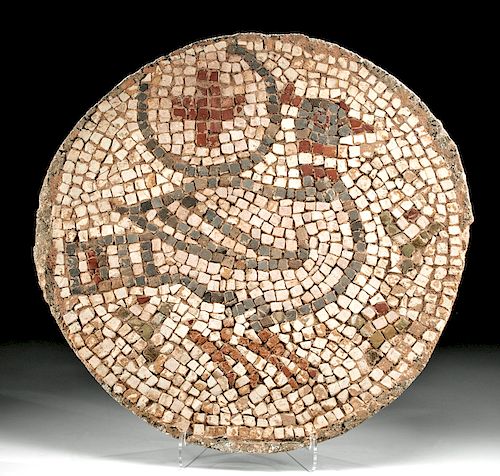Byzantine Stone Mosaic w/ Pheasant
Lot 101a
About Seller
Artemis Fine Arts
686 S Taylor Ave, Ste 106
Louisville, CO 80027
United States
Selling antiquities, ancient and ethnographic art online since 1993, Artemis Gallery specializes in Classical Antiquities (Egyptian, Greek, Roman, Near Eastern), Asian, Pre-Columbian, African / Tribal / Oceanographic art. Our extensive inventory includes pottery, stone, metal, wood, glass and textil...Read more
Estimate:
$3,000 - $4,500
Absentee vs Live bid
Two ways to bid:
- Leave a max absentee bid and the platform will bid on your behalf up to your maximum bid during the live auction.
- Bid live during the auction and your bids will be submitted real-time to the auctioneer.
Bid Increments
| Price | Bid Increment |
|---|---|
| $0 | $25 |
| $300 | $50 |
| $1,000 | $100 |
| $2,000 | $250 |
| $5,000 | $500 |
| $10,000 | $1,000 |
| $20,000 | $2,500 |
| $50,000 | $5,000 |
| $100,000 | $10,000 |
| $200,000 | $20,000 |
About Auction
By Artemis Fine Arts
Sep 26, 2019
Set Reminder
2019-09-26 10:00:00
2019-09-26 10:00:00
America/New_York
Bidsquare
Bidsquare : Exceptional Day 1: Antiquities & Asian Art
https://www.bidsquare.com/auctions/artemis-gallery/exceptional-day-1-antiquities-asian-art-4437
Day 1 of an important 2-day auction featuring exceptional, museum-worthy examples of Egyptian, Greek, Etruscan, Roman, Viking, Russian, Near Eastern, as well as Asian Art from China, Japan, Thailand, Vietnam, Burma and India. Artemis Fine Arts info@artemisfinearts.com
Day 1 of an important 2-day auction featuring exceptional, museum-worthy examples of Egyptian, Greek, Etruscan, Roman, Viking, Russian, Near Eastern, as well as Asian Art from China, Japan, Thailand, Vietnam, Burma and India. Artemis Fine Arts info@artemisfinearts.com
- Lot Description
Near East/Holy Land, Early Byzantine, the Levant, ca. 5th to 6th century CE. A charming stone mosaic composed of tiny tesserae of many different colors. At its center is a pheasant, rendered in an outline, with a pert head and crest, standing upright on large feet. Above the head of the pheasant is a red cross encircled by the same blue as the outline of the pheasant. Two leafy plants are at the pheasant's side, giving an appearance of abundance. The rest of the piece is composed of creamy white tesserae, giving it a bright appearance. Size: 17" W (43.2 cm)
The pheasant was an important bird in the ancient world, and Byzantines bred them for the table but also admired their beauty. The Romans had imported them from Asia and then spread them to southern Europe via Greece and into the Levant. Mosaics (opus tesellatum) are some of our enduring images from the Classical and post-Classical world, appreciated not only for their aesthetic beauty, but also because they reveal what people chose to depict and see every day decorating their private and public spaces. Birds - and indeed, animals of all kinds - were incredibly popular artistic themes in mosaics. Based on where mosaics depicting them have been found, birds seem to have been considered tranquil, peaceful subjects for the interiors of homes (not so the case with many other types of animals). Let this image grace your living space with a similar peacefulness!
Provenance: private J.H. collection, Beaverton, Oregon, USA
All items legal to buy/sell under U.S. Statute covering cultural patrimony Code 2600, CHAPTER 14, and are guaranteed to be as described or your money back.
A Certificate of Authenticity will accompany all winning bids.
We ship worldwide and handle all shipping in-house for your convenience.
#149592Mounted on concrete. The edges have some losses. Otherwise there is normal surface wear with some chips and nicks to the surface. Losses to tesserae at peripheries and some interior areas.Condition
- Shipping Info
-
All shipping is handled in-house for your convenience. Your invoice from Artemis Gallery will include shipping calculation instructions. If in doubt, please inquire BEFORE bidding for estimated shipping costs for individual items.
-
- Buyer's Premium



 EUR
EUR CAD
CAD AUD
AUD GBP
GBP MXN
MXN HKD
HKD CNY
CNY MYR
MYR SEK
SEK SGD
SGD CHF
CHF THB
THB














